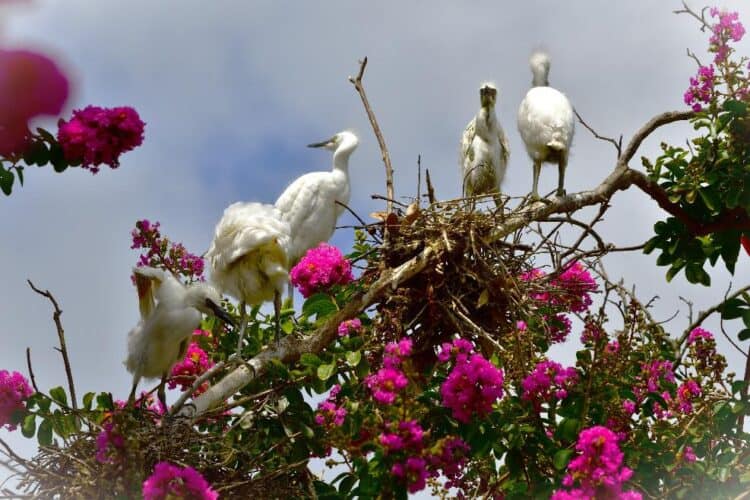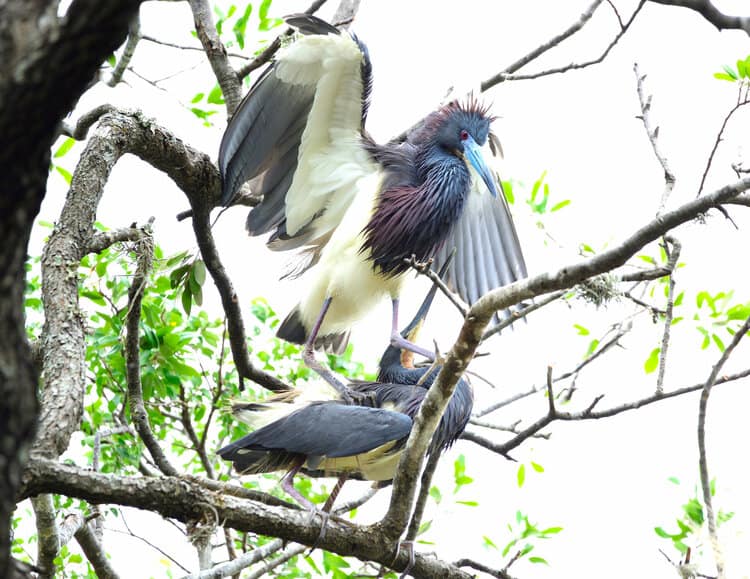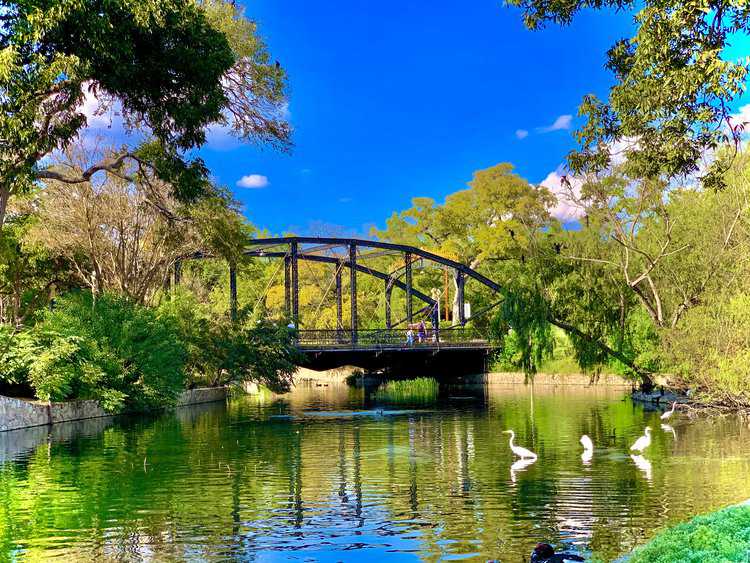Brackenridge Park: As I held a rescued newly hatched Egret chick in my hand back in 2021, I should have known what lie ahead for the migratory birds-a future of harassment, destruction of habitat, and most likely death.

Years ago, I overheard someone with the City of San Antonio (COSA) say “they had an Egret problem. Standing here today, I must say-maybe it is not so much an Egret problem we have here, maybe it’s a human problem, maybe we are the problem?
I found the waterbirds at Brackenridge Park in early 2013, Migratory Egrets and Herons. I would join the birds on their journey, as I watched as they arrived, built their nests, incubated their eggs, raised their young and then gathered in the river to migrate south. Some flying long distances, over vast areas, many between countries to winter grounds along the Gulf of Mexico coastline, Mexico, Central America and as far away as South America.

The History of the Birds: The North American Waterbird Conservation Plan reports that, “Waterbirds have been cherished by humans and societies for centuries. They have inspired poetry, music, and fables. The habitats of waterbirds-the important sites on which they depend for nesting, feeding, and wintering are also at risk due to human related and natural threats.” north-america-waterbird-conservation-plan.pdf (fws.gov)

The Yellow-Crowned Night-Herons are one of the first to arrive in central Texas, they migrate a great distance. With their range extending to South America. Some of the Herons are listed as state Endangered in several US states. The oldest documented, Yellow-Crowned Night-Heron lived only 6.3 years, not long at all.


The Great Egret, a species once almost hunted to extinction for their plumes arrive next. Snowy Egrets and Little Blue Herons arrive in pairs just after the spring equinox. Then come the Tricolored Herons, a Texas Protected Species, that have produced around eight nests a year, with many lost- we suspect due to disturbance by humans.


The Cattle Egrets make up the largest number of the breeding birds. The birds quickly get to work on building nests, diving into the river and searching far and wide for the perfect twig. Cormorants would come later in the year, the Sacred Waterbird of local Indigenous people, now also face the threat of destruction to their nesting habitat.

According to the Texas State Historical Association information page on Cattle Egrets, “Heronries near human habitation cause noise, odor, and fear of diseases. However, there is no evidence that cattle egrets have introduced diseases or parasites detrimental to humans or native egrets or herons.” The birds are often called a nuisance for their droppings, misrepresented as a “health hazard to humans.”
I would soon come to learn that the actions of some humans can be a far greater hazard than anything the birds do!
Eric Allen of Foster, CA is a waterfowl expert and goose advocate, shared that “nuisance” is subjective. “What is a nuisance to some is not a nuisance to others. For example, a large population of geese at a park, blocking the sidewalks that are covered in droppings could be a nuisance to person A, but not a nuisance to me, not to a lot of people. Person A may feel upset or inconvenienced by the presence of the droppings or the need to walk around a group of geese. However, I am in their home, their habitat. I coexist with wildlife and have no problem stepping over or around the results of their natural behavior. Where there’s water, there are waterbirds-that is nature. Forcing ourselves to dominate nature is not feasible or sustainable, and there is no reason to kill animals.”
Writer and educator, Mirasol Cortez author of, In Praise of Nuisance Heronries, writes “to tell the story of this conflict over birds in public spaces, then, it is necessarily to tell the story of the local knowledge these women—alongside many other long-time residents—have accumulated about the egret and heron communities the Texas Parks and Wildlife Department refers to as “nuisance heronries.” In Praise of Nuisance Heronries (Part One) | Deceleration
Our journey begins in 2017: The Egrets and Herons are nesting on the northwest side of the San Antonio River in Oaks and other trees in an area called Lambert Beach, located across the river from the main area of the park. By 2018, I was completing a Breeding bird survey and learning about each different species, their migration range, and conservation needs.
And then came the smell: The first week of April 2018-a heavy, sickening chemical scent fills the air over the river in the most publicly used area of the park. The birds and public would be exposed to an EPA registered pesticide. The COSA would post multiple signs that read, “the device emits a grape extract vapor – suitable to be used around people, pets and animals.”

Most chicks will not survive-with the biggest threat to the waterbirds caused by disturbance by humans.
The public and nesting birds would be fogged in April and May of 2018. A commercial contractor is hired to fog the spray in August and September. The sprayers would be shut off after an investigation by Texas Department of Agriculture’s (TDA) Pesticide Division with a Notice of Violation issued to the COSA and contractor.
About the Spray: The Hazardous Substance Database (HSDB) of the National Library of Medicine (NLM) indicates that Methyl Anthranilate, the active ingredient in the pesticide, has a grape odor, but reports that the product is prepared by heating anthranilic acid with methanol in the presence of hydrochloric acid, with subsequent distillation. The chemical mixture, with identified irritants, may cause adverse effects to humans and to the environment. The Safety Data Sheet or SDS states that the product is not to be used near surface water because it is slightly toxic to fish and invertebrates. The city fogged anyway.
How does it work? The spray irritates the bird’s mucous membrane causing them to avoid the area. The methyl anthranilate irritates the pain receptors associated with the bird’s sense of smell and taste.
The birds would not abandon their nests, staying to incubate their eggs and soon chicks would hatch into a fog of chemicals directed at them from the roof of a children’s playscape and a sprayer inside the Zoo. Suspicious deaths of adult Little Blue Herons, a few Cattle Egrets, many bloodied chicks, the aftermath of the chemical fog.

Brackenridge Park-Spring 2019: Removal of the small trees the birds had nested in the previous year pushed the birds to seek out new trees on the opposite side of the river, some into Crape Myrtle trees. Some birds staying away from the larger oak trees until the first heavy rains and then returning to the Oaks.
New “warning” signs posted near the river and Zoo side of the park advertises that you are, “Entering an Avian Control Zone, Device is in Operation.” A plume of chemical drift would cause slight chemical burns to my eyes, with Anaphylaxis leading me to seek Urgent Care. The devices would be shut off sometime afterwards!
The birds would build their nests, sit on their eggs, feed their chicks then gather in the river to migrate south for the winter, completing the breeding season here in San Antonio.
2019 Elmendorf Lake Park Bird Island: Cattle Egrets are proclaimed a threat to military planes at former Kelly Air Force Base, now Joint Base San Antonio (JBSA) as a Bird Aircraft Strike Hazard (BASH). Eggs discovered in one nest cause a delay to the planned assault on Bird Island.

Elmendorf lake park is a stopover habitat for migratory birds and nesting site for Egrets and Herons spanning decades according to resident, Kamala Platt, PHD. Platt moved to the neighborhood after observing the beautiful Egrets on Bird Island nesting, reminiscent to her of Atzlan, Place of Herons. Atzlan is the ancestral home of the Aztec people.

Marisol Cortez writes in Praise of Nuisance Heronries Part 1: Bird-dispersing chemical warfare comes to the Westside’s little Aztlan, our ‘place of herons.’ Cortez writes, “Is the problem that egrets are hazardous? Or is the problem the might-makes-right thinking that a city which prides itself on being “Military City, USA” employs in putting the arbitrary flightpaths of military vehicles before the ancient ones of birds? “Or is it the elevation of warfare itself above the right of non-humans (and many humans as well) to exist, much less co-exist?”
Read More: In Praise of Nuisance Heronries (Part Two) | Deceleration
Winter 2019: Greg Harman, Editor of Deceleration News was onsite during the destruction to Bird Island and shared his observations and video here:
Watch: VIDEO: Destruction of San Antonio’s Bird Island | Deceleration
Alesia Garlock
Wildlife / Environmental Advocate! I fight to protect nature. Informing the public of hidden agenda!





Leave a Reply